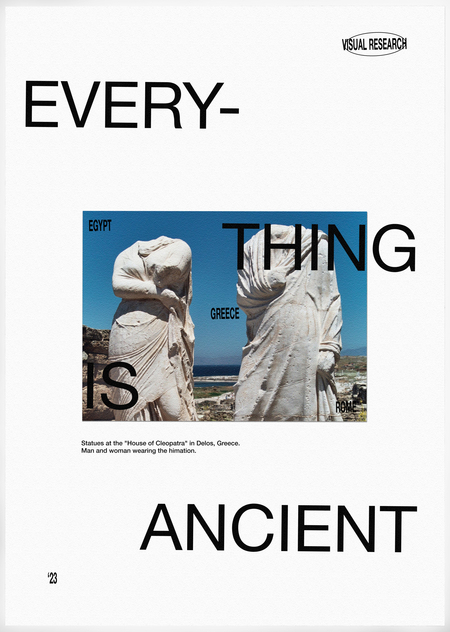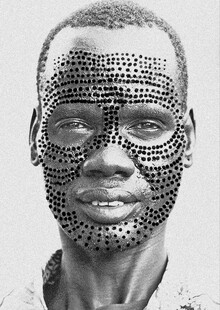
Ancient Influences on Contemporary Fashion
Table of Contents.
1. Introduction 2. Ancient Egypt 3. Ancient Greece 4. Ancient Rome 5. Conclusion 6. Reference List
Fashion, just as art, design and architecture, has always been known to take inspiration from the Ancient times — regardless whether those adaptations were minute or grand.
When it comes to aestheticism, Ancient Egypt, Ancient Greece and Ancient Rome are universally believed to be among of the most influential and groundbreaking civilizations, forever changing the way we view human body and the visuals surrounding it. The remnants of their art continue to resonate in modernity, seamlessly intertwined into the design of garments, accessories, and overarching stylistic choices.
Ancient Egypt with its opulent, symbolic yet elegant attire serves as a timeless source of inspiration for contemporary fashion.
The iconic headdresses, colorful wide-collar necklaces and bracelets, pristine flat silhouettes and intricate patterns find a place in high-fashion and ready-to-wear collections alike. Designers draw inspiration from both the regality and decadence of pharaonic garments, translating the essence of ancient Egyptian style into garments that can exude both luxury and mystique.
Moving westward, Ancient Greece emerges as a perennial gamechanger in the way we view fabrics and garment construction with classical simplicity of Greek tunics and the graceful drapery inspired by the chiton.
The revival of the Grecian aesthetic in the XX and XXI century is evident in flowing dresses, one-shoulder silhouettes, and column-like minimalist gowns that evoke the poise and sophistication of ancient Greek attire.
Ancient Rome is known for its architectural grandeur and military influence as well fashion that favored decorative styles and comfort over simplicity.
The iconic Roman toga finds its modern counterpart in draped evening gowns and flowing dresses, while the use of gladiator-inspired sandals and intricate leatherwork pays homage to the footwear trends of ancient Rome. The classical architecture and geometric patterns of Roman design often manifest in contemporary prints and embellishments.
My research explores the intersection of historical and contemporary fashion, investigating how ancient cultural, artistic and sartorial influences have shaped and continue to permeate what we consider fashion today. This project aims to unravel both direct and indirect connections between the far past and the present in the realm of style, providing insight into the enduring impact of ancient design on today’s fashion landscape by examining specific elements and details from the fashions of Ancient Egypt, Greece and Rome.
The principal goal of this research is to outline the essential and indisputable role art and fashion of Ancient civilaztions had played in the formation of fashion design and the aesthetics of human beauty as we know them today.
Ancient Egypt
Tomb of Merymery relief, c. 1390-1352 B.C.
Egyptian fashion, along with Mesopotamian, was the first to introduce fashion as such an intricate tool to distinguish between people of different status and class. At a mere glance, one could easily recognize a pharaoh or a chantress, or could never mistake a commoner for a high-ranking official — and vice-versa.
The gold mask of Tutankhamun, c. 1325 B.C.
Ancient Egypt’s use of fashion as a tool of social division has solidified our obsession with statement jewelry pieces as a symbol of wealth and class — gold is especially definitive when it comes to ‘loud’ luxury.
Chanel Pre-Fall 2019 necklace and a broad collar necklace depicted in Nebamun Hunting in the Marshes, c. 1350 B.C.
Chanel Pre-Fall 2019 golden heels and Gold Sandals of Shoshenq II, c. 887-885 B.C.
GUCCI Resort 2019 Scarab Beetle brooch and necklace and King Tutankhamun Scarab Necklace c. 1332-1323 B.C.
Chanel Pre-Fall 2019 dress with embellishments and a dress depicted in Osiris with Isis and Nephthys, c. 1300 B.C.
Tomb painting in the Tomb of Sobekhotep, c. 1400 B.C.
Despite the colorful aura surrounding the term ‘orientalism’ widely associated with Egypt’s culture, visual minimalism depicted in Ancient Egypt’s masterful use of fabric stands as one of the most vital pillars of contemporary fashion and design in general.
Red lining in Chanel Pre-Fall 2019 and Khonsu-mes receives libation of food and drink from the tree goddess, Papyrus of Khonsu-mes, c. 1000 B.C.
The Row Spring 2023 Read-To-Wear and Women carrying offerings, depicted within the Tomb of Menna, c. 1550-1292 B.C.
The Row Resort 2019 and The Bersha Procession, c. 2010–1961 B.C.
The Row Spring 2023 Ready-To-Wear and Khonsu-mes receives libation of food and drink from the tree goddess. Papyrus of Khonsu-mes, c. 1000 B.C.
Anteprima Spring 2016 Ready-To-Wear and Ancient Egyptian faience beaded fishnet dress, c. 2551-2528 B.C.
An Egyptian polychrome and gilt cartonnage mummy mask, c. 100-30 B.C.
Checkered patterns have stayed ubiquitous in fashion ever since the days of Ancient Egypt, with many resurgences throughout its history; and many designers and fashion houses appropriating the check as part of various aesthetics — from traditional to minimalist to subversive.
Undercover Fall 2023 Ready-To-Wear and The Mummy Shroud of a Woman and a Boy, с. 2nd Century, A.D.
MM6 Maison Margiela Spring 2022 Ready-To-Wear.
Egyptian influence has infiltrated not only mainstream fashion, but also more subversive, subcultural styles. The distressed look, especially popular right now with the revival of the 90s- and 2000s-inspired fashion, takes its roots from the process of aging and decomposition of fabric, both of which can perceived in the way Egyptian mummies have fared over the years.
Demobaza Ninja Top Aware and The Mummy of King Ramesses II, c. 1213 B.C.
Demobaza CARDIGAN TIMELINE M.
KNWLS AW23 Collection and The Mummy of Thutmose III, c. 945 B.C.
KNWLS AW23 Collection and The Mummy of King Merenptah, c. 1203 B.C.
Iris Van Herpen Fall 2009 Ready-To-Wear.
Ancient Greece
Ancient Greece was perhaps the biggest influence on the development of the Minimalist movement in fashion. With the Greeks' masterful understanding of fabric and composition, draping, layering and imported transparent fabrics such as silk began to spread widely. Those techniques still serve as a backbone behind most stylistic and design choices to this day.
Ancient Greece Marble Votive Relief Dedicated to the Nymphs, c. 330-320 B.C.
'Draping' is unanimously the first term to come to mind when looking to describe Greek fashion. 'Draping' is an intricate technique achieved by positioning, pinning, tying or stiching together loose parts of fabric to structure a garment.
Louis Vuitton Pre-Fall 2023 wrapped linen skirt and The Varvakeion Athena, c. 200–250 A.D.
Marine Serre Spring 2020 Ready-To-Wear and Marble statue of a Nereid or Aura on horseback, from the temple of Asklepios at Epidauros, c. 380 B.C.
Vejas Spring 2020 Ready-To-Wear and Marble Grave stele of Mnesagora and Nikochares from Vari, c. 420-410 B.C.
In Ancient Greece, tied knots and wrapped-around parts were heavily relied on to help make a garment a stay put on the body, but also for additional coverage. Nowadays, those same techniques are used to create and accentuate a silhouette of one’s body in a strive for a more romantic look.
Thom Browne Fall 2023 Haute Couture and Marble statuette of the goddess Hygieia, found in the sanctuary of Asklepios at Epidauros. c. 200 A.D.
Miu Miu Fall 2022 Ready-To-Wear and Marble Relief Slab from the Revetment of a Pedestal or of an Altar, Found at Mantineia, Arkadia, c. 330-320 B.C.
Pleating, a more modern folding technique, uses the foundation of draping to create a sleeker, sophisticated but utilitarian look.
Statuette of Hygieia from Epidaurus, c. 400 B.C.
Off-the-shoulder look, once treasured by the Greek commonfolk for its comfortability and utility, is now often deemed feminine, mature and sometimes daring.
Rick Owens Spring 2024 Ready-To-Wear and Marble grave stele of a youth, from Aegina island or Salamis island, 430 — 420 B.C.
Ancient Rome
The Grave relief of Publius Aiedius and Aiedia, c. 30 B.C.
Ancient Roman fashion was built upon only a handful of staple pieces: togas, tunics, stolas, pallas, sandals, and later on, trousers. To steer clear of the Greek minimalism but still remain elegant and sophisticated, Romans took it further with decorativism, layering, semi-opaque fabrics, vibrant colours, and, of course, partial nudity.
Yohji Yamamoto Spring 2021 Ready-To-Wear and Tiberius in an imperial Roman toga, c. 14–37 A.D.
Excessive, almost counter-utilitarian layered togas, worn mostly by men, were a must for any occasion — whether it was everyday wear or a formal gathering. Togas varied in length and intricacy of draping, with some showing almost no skin at all and other barely covering anything.
Saint Laurent Spring 2023 Ready-To-Wear and The Orator, c. 100 B.C.
Richard Malone Spring 2020 Ready-To-Wear and Marble statuette of triple-bodied Hekate and the three Graces, c. 100-200 A.D.
Romans were not afraid to display full-frontal nudity, even though such views weren’t shared by all citizens of the Roman Empire. Women wore stolas and pallas made either entirely of silk or layered with cotton, woolen and linen fabrics to create a more enticing, covered look. Our views on nudity has changed drastically over the centuries, but in the XXI century, it seems to had come full-circle.
Blumarine Spring 2023 Ready-To-Wear and a maenad wearing a silk gown, a Roman fresco from the Casa del Naviglio in Pompeii, c. 100 A.D.
Mugler Spring 2024 Ready-To-Wear.
Mosaic from Villa del Casale, Sicily, c. 400 A.D.
Loinclothss, or subligacula and subligaria, started surfacing in Rome as a form protective underwear for women. Mostly worn under tunics for everyday wear, they were still often used as outerway during sports competitons by higher-ranking women, and as an only article of clothing by slaves who had to endure hot and dirty working conditions. In 2023, undergarments are appearing on runways as a bold fashion accessory, and are slowly making their way into Eruopean and American streetstyle as well.
Miu Miu Fall 2023. Undergarments that are used as outer clothes.
Short trousers, known in Ancient Rome as 'bracae' or 'feminalia', gained quick populairy as military attire around 200 B.C. As the empire expanded, trousers became more widely adopted, mostly for practical reason. Although contemporary trousers have greatly evolved, body-tight 'capri' pants, visually resembling those of the Roman Empire, are coming back in fashion due to the revival of the 2000s.
Miu Miu Fall 2023 and Address of emperor to soldiers, relief on south side, c. 175-196 A.D.
Sandals, 'calcei' or 'soleae', were a ubiquitous and essential element of footwear in the Roman Empire, reflecting the warm climate and practical needs of the time. The simplicity of their design allowed for ventilation, while leather and a reinforced sole of their military counterpart, 'caligae', or what now is reffered to as a 'gladiator’s sandals', served as a durable and protective piece during long matches.
A Roman fresco depicting the goddess Diana hunting, c. 400 century A.D., from the Via Livenza hypogeum in Rome.
Staud Nicola Gladiator Heels and Sandali Paride in grosgrain.
Miu Miu Spring 2023 Ready-To-Wear leather sandals and a Marble statue of Mars from the Forum of Nerva, c. 200 A.D.
Birkenstock Boston clogs, contemporary sandal classic.
Conclusion
The relics of Anicent fashion can be seen in virtually all aspects of contemporary fashion, whether it is mass-market, luxury, ready-to-wear or haute couture alike. The integration of Ancient ways into today’s perception of human aesthetics showcases a continuous dialogue between the past and the present, allowing fashion to recreate and recycle itself, both transcending time and allowing us to connec with the enduring allure of the antique.
https://i0.wp.com/egypt-museum.com/wp-content/uploads/2023/09/beadnet-dress-of-faience-cylinder-beads.jpg?ssl=1 (Accessed 29/11)
https://i0.wp.com/egypt-museum.com/wp-content/uploads/2023/11/Gold-Sandals-of-Shoshenq-II-2.jpg?ssl=1 (Accessed 29/11)
https://egypt-museum.com/nebamun-hunting-in-the-marshes (Accessed 29/11)
https://egypt-museum.com/tutankhamun-scarab-necklace/ (Accessed 30/11)
https://www.vogue.com/fashion-shows/spring-2016-ready-to-wear/anteprima/slideshow/collection#17 (Accessed 30/11)
https://assets.vogue.com/photos/5c072e22aa3e462d559d31c5/master/w_2240,c_limit/_ALE0523.jpg (Accessed 30/11)
https://media.neimanmarcus.com/f_auto,q_auto:low,ar_4:5,c_fill,dpr_2.0,w_790/01/nm_4505853_100236_m (Accessed 30/11)
https://www.vogue.com/fashion-shows/spring-2022-ready-to-wear/mm6-maison-martin-margiela/slideshow/collection#8 (Accessed 1/12)
https://www.namuseum.gr/en/collection/klasiki-periodos-2/# (Accessed 1/12)
https://egypt-museum.com/the-bersha-procession/ (Accessed 1/12)
https://i0.wp.com/egypt-museum.com/wp-content/uploads/2022/08/Mummy-of-King-Ramesses-II-1.jpg?w=1280&ssl=1 (Accessed 1/12)
https://egypt-museum.com/mummy-of-thutmose-iii/ (Accessed 1/12)
https://i0.wp.com/egypt-museum.com/wp-content/uploads/2023/11/The-Mummy-of-King-Merenptah.jpg?ssl=1 (Accessed 1/12)
https://knwls.com/cdn/shop/files/KNWLS_AW23_004_e2992c89-ba0e-42bd-acf2-6b5d8f1d9ab2_2000x.jpg?v=1699455821 (Accessed 1/12)
https://www.vogue.com/fashion-shows/fall-2009-ready-to-wear/iris-van-herpen/slideshow/collection#3 (Accessed 1/12)
https://assets.vogue.com/photos/5d9c804944ae050008c96086/master/w_2580%2Cc_limit/00012-Vejas-SS20-Ready-to-Wear.jpg (Accessed 1/12)
https://en.wikipedia.org/wiki/Roman_sculpture#/media/File: -0030_Grabrelief_Publius_Aiedius_Amphio_und_Frau_Aiedia_Altes_Museum_anagoria.JPG (Accessed 1/12)
https://kids.britannica.com/students/assembly/view/7800 (Accessed 1/12)
https://www.metmuseum.org/art/collection/search/255881 (Acessed 1/12)
https://www.vogue.com/fashion-shows/spring-2024-ready-to-wear/mugler/slideshow/collection#37 (Accessed 2/12)
https://www.vogue.com/fashion-shows/spring-2023-ready-to-wear/blumarine/slideshow/collection#11 (Accessed 2/12)
https://egypt-museum.com/mask-of-tutankhamun/ (Accessed 2/12)
https://www.vogue.com/fashion-shows/spring-2021-ready-to-wear/yohji-yamamoto/slideshow/collection#1 (Accessed 2/12)
https://assets.vogue.com/photos/63335b928780c7680855b5c1/master/w_2240,c_limit/00011-saint-laurent-spring-2023-ready-to-wear-credit-gorunway.jpg (Accessed 2/12)
https://www.vogue.com/fashion-shows/spring-2023-ready-to-wear/row/slideshow/collection#37 (Accessed 2/12)
https://ancientrome.ru/art/artworken/img.htm?id=2819 (Accessed 3/12)https://commons.m.wikimedia.org/wiki/File:Statuette_of_Hygieia_from_Epidaurus_at_the_National_Archaeological_Museum_of_Athens_on_27_March_2018.jpg (Accessed 3/12)
https://assets.vogue.com/photos/5d9c804897987700086bc7a4/master/w_2580%2Cc_limit/_SDR0174.jpg (Accessed 3/12)
https://commons.wikimedia.org/wiki/File:Ancient_Greece_Marble_Votive_Relief_Dedicated_to_the_Nymphs,_c._330-320_BC.jpg (Accessed 3/12)
https://www.vogue.com/fashion-shows/spring-2023-ready-to-wear/miu-miu/slideshow/collection#1 (Accessed 4/12)
https://www.vogue.com/fashion-shows/fall-2023-ready-to-wear/undercover/slideshow/collection#16 (Accessed 4/12)
https://www.vogue.com/fashion-shows/fall-2023-ready-to-wear/miu-miu/slideshow/collection#15 (Accessed 4/12)
https://www.vogue.com/fashion-shows/fall-2023-ready-to-wear/miu-miu/slideshow/collection#48 (Accessed 4/12)
https://www.vogue.com/fashion-shows/fall-2023-ready-to-wear/miu-miu/slideshow/collection#40 (Accessed 4/12)



